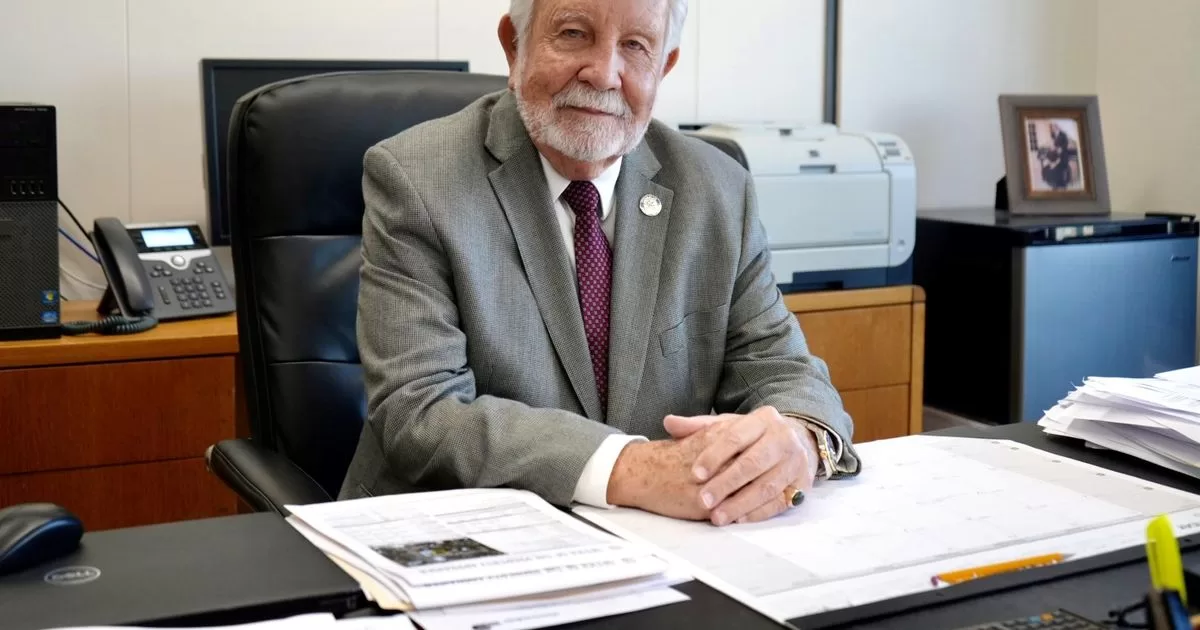The Argentine mining industry celebrates today the “Mining Day”, in commemoration of the date of sanction of the first “Ley de Fomento Minero” of Argentina, 210 years ago, on May 7, 1813, by the Constituent Assembly of that year, the same as three months and three days before, on February 4, it had declared free all slaves who entered the “United Provinces of the Río de la Plata” in that condition, the beginning of the end of slavery in the territory Argentinian.
In this context, the Chamber of Mining Entrepreneurs of Argentina (CAEM), gave a few days ago the details of “Arminera 2023”, the 25th edition of the sector’s fair, which after three years of interruption due to the pandemic, will be held This year, from Monday May 22 to Wednesday May 24, at the premises of the Argentine Rural Society (SRA) in Palermo.
The event, in whose organization Messe Frankfurt Argentina participated, will be spread over more than 15,000 square meters of the fairgrounds, bringing together more than 10,000 participants -operators, suppliers, professionals, investors, scientists and technicians- from different countries. More than 220 exhibitors will speak and show the advances of the sector in products and services in 4 Halls, in panels, presentations and exhibitions on topics such as Economy, Innovation, Gender, Environment and Sustainability, explained the president of CAEM, Franco Mignaccothe executive director of the entity, Alexandra Cardonaand Ezequiel Gorbaranfrom Messe Frankfurt.
There will even be a “Plaza de Máquinas”, in addition to business rounds, a section on the “Partnership on Raw Materials” between Europe and Latin America, a short film on “Women in Mining” will be screened, and there will be heavy visitors like Pierre Gratonpresident and executive director of the Mining Association of Canada, which together with Australia (a country on which there will be a specific seminar) are very strong in mining matters.
The Minister of Economy, Sergio Massaand the Secretary of Mining, Fernanda Avilaare of course invited, although the head of the Treasury has not yet confirmed their attendance, Mignacco said.
:quality(85)/cloudfront-us-east-1.images.arcpublishing.com/infobae/3U35IBRYZFCYDA3TUNYS5GVQMA.jpg%20420w,https://www.infobae.com/new-resizer/e5uSHafTovMbus5Vk9fLz6TNv0k=/768x432/filters:format(webp):quality(85)/cloudfront-us-east-1.images.arcpublishing.com/infobae/3U35IBRYZFCYDA3TUNYS5GVQMA.jpg%20768w,https://www.infobae.com/new-resizer/1gxRdvP71fDu7RPnWTrGjPap3YY=/992x558/filters:format(webp):quality(85)/cloudfront-us-east-1.images.arcpublishing.com/infobae/3U35IBRYZFCYDA3TUNYS5GVQMA.jpg%20992w,https://www.infobae.com/new-resizer/wT5JbfTHukng6tX_3EvmuDF8IAU=/1200x675/filters:format(webp):quality(85)/cloudfront-us-east-1.images.arcpublishing.com/infobae/3U35IBRYZFCYDA3TUNYS5GVQMA.jpg%201200w,https://www.infobae.com/new-resizer/ZL979qEu66q-D7ViA84TmY1ZBmU=/1440x810/filters:format(webp):quality(85)/cloudfront-us-east-1.images.arcpublishing.com/infobae/3U35IBRYZFCYDA3TUNYS5GVQMA.jpg%201440w)
In the presentation, the CAEM highlighted both the present and the potential and projection of mining in the country, highlighting, among other things, that Argentina:
-It is the fourth world producer of lithiuma mineral on which there is more than USD 5,000 million of investment between projects already in operation and others in the construction or advanced exploration stage and explains more than 60% of the exports of the postponed Argentine Northwest (NOA).
-It has 2 of the 25 largest gold mines in the worldVeladero and Cerro Negro, in San Juan and Santa Cruz, respectively, and with 10 active gold operations, to the point that gold exports today account for 56% of the external sales of Argentine mining.
-It is the tenth largest producer and holds 2.5% of world silver reservesand has 5 projects in advanced feasibility exploration, in Santa Cruz, Chubut and Salta.
-It can involve up to 12,000 jobs in construction and 4,500 in operation of the 5 most advanced copper production projects.
Mining is one of the few sectors of the economy with a surplus balance of foreign currency (80% of its inputs and services are provided locally), in 2022 it exported almost USD 3.9 billion, paid national, provincial and municipal taxes for $141 billion and the account of the work generated is close to 100,000 jobs between direct and indirect around the activity, specified CAEM in a summary on the situation and perspectives of the sector.
:quality(85)/cloudfront-us-east-1.images.arcpublishing.com/infobae/V6TF4WLZFJAHJO7KGWGJWN47UM.jpg%20420w,https://www.infobae.com/new-resizer/-R3ot-JK5OplwMCEYAZPA1IR4F0=/768x432/filters:format(webp):quality(85)/cloudfront-us-east-1.images.arcpublishing.com/infobae/V6TF4WLZFJAHJO7KGWGJWN47UM.jpg%20768w,https://www.infobae.com/new-resizer/wLLM9EiYI6fDc5KS6JjA7n9TmHk=/992x558/filters:format(webp):quality(85)/cloudfront-us-east-1.images.arcpublishing.com/infobae/V6TF4WLZFJAHJO7KGWGJWN47UM.jpg%20992w,https://www.infobae.com/new-resizer/zNKI0-zxCukRbN2z99r_t4N3SgQ=/1200x675/filters:format(webp):quality(85)/cloudfront-us-east-1.images.arcpublishing.com/infobae/V6TF4WLZFJAHJO7KGWGJWN47UM.jpg%201200w,https://www.infobae.com/new-resizer/GaZyDgx3bKvDWwX1EF_Zq9IfiDs=/1440x810/filters:format(webp):quality(85)/cloudfront-us-east-1.images.arcpublishing.com/infobae/V6TF4WLZFJAHJO7KGWGJWN47UM.jpg%201440w)
The potential is much greater still: Argentina shares the same mountain range with Chile, and while mining exports from the trans-Andean country exceed USD 60,000 million, Argentina does not reach 4,000 million, a difference of more than 15 times, highlighted Mignacco, in what is almost a slogan, a call to action and an appeal to the “liberation” of the sector. According to CAEM, mining could triple exports in less than ten years.
A world in rapid “energy transition” and eager to leave fossil fuels behind implies a global appetite for “critical minerals” that Argentina already produces and has in abundance, such as lithium, and for a metal such as copper, of which, With stable investments, macroeconomics and rules of the game, it could produce more than one million tons per year, as the projects come on stream.
But not all are good. For example, in “Arminera 2023″ CAEM will present the first “Argentine Mining Cost Index”. Costs affected -as in so many other sectors- by the intricate current exchange system. Worse still, Mignacco and Cardona explained, the sector has more than 4,000 SIRAs and SIRASEs (import procedures for goods and services) pending, which makes activity difficult, particularly in the supplier sector, populated by mining SMEs.
:quality(85)/cloudfront-us-east-1.images.arcpublishing.com/infobae/XMGC2RLQKBDPHPF7ZTU36BN4W4.jpg%20420w,https://www.infobae.com/new-resizer/zD7LCCUJGWILuqhhoyrC0ZMSxR8=/768x341/filters:format(webp):quality(85)/cloudfront-us-east-1.images.arcpublishing.com/infobae/XMGC2RLQKBDPHPF7ZTU36BN4W4.jpg%20768w,https://www.infobae.com/new-resizer/FjL9r-6mHl8GQrDSySwSXP0ceSA=/992x441/filters:format(webp):quality(85)/cloudfront-us-east-1.images.arcpublishing.com/infobae/XMGC2RLQKBDPHPF7ZTU36BN4W4.jpg%20992w,https://www.infobae.com/new-resizer/MGLWUw3GkpwqMO3WBKyZvqZUulk=/1200x533/filters:format(webp):quality(85)/cloudfront-us-east-1.images.arcpublishing.com/infobae/XMGC2RLQKBDPHPF7ZTU36BN4W4.jpg%201200w)
In addition, although the commitment to the energy transition and the competition for critical minerals is a firm trend, mineral prices are not exempt from curves and counter-curves. For example, the price per ton of lithium carbonate (LCE, the chemically processed form in which Argentina exports the lithium that it has so far extracted from brines in Salta and Jujuy, to which it will soon add production and export from Catamarca), fell more than 60% since the end of last year.
Just as in 2022 mineral exports grew driven by the phenomenal price increase, this year they could be affected by the opposite. Although lithium is not a commodity, in the sense that it does not have a firmly established market price and is largely driven by long-term contracts between producers and buyers (battery producers and large automakers), there are indices and centers that follow the trend. The attached graph, from Trading Economics, shows the evolution of the price of a ton of LCE in dollars in the last 5 years. Both the rise in 2022, to USD 60,000, and the plummeting since November, prolonged to the present, can be seen there, with a slight rebound at the end of the week. This fall is due, they explain in the sector, to the withdrawal by China of a series of stimuli for the production and acquisition of electric vehicles and to recessive trends in the world economy.
None of this is innocuous for the economy, just as inflation, jumps in the exchange rate, obstacles and macroeconomic uncertainty are not for any sector, which make the cost of credit more expensive and have a strong impact on capital-intensive industries and investment horizons. long term, such as mining.
:quality(85)/cloudfront-us-east-1.images.arcpublishing.com/infobae/D27BHRU7NFH7FEAYRVSH7KSSRE.jpg%20420w,https://www.infobae.com/new-resizer/ZR7WDnKhDYUgmDL0QI9kyLl76s0=/768x512/filters:format(webp):quality(85)/cloudfront-us-east-1.images.arcpublishing.com/infobae/D27BHRU7NFH7FEAYRVSH7KSSRE.jpg%20768w,https://www.infobae.com/new-resizer/7hsObqcLqN2GhDqe3QvqvVYcUuA=/992x661/filters:format(webp):quality(85)/cloudfront-us-east-1.images.arcpublishing.com/infobae/D27BHRU7NFH7FEAYRVSH7KSSRE.jpg%20992w,https://www.infobae.com/new-resizer/XKUK0w8kyAtZiGJaFWFofN6NcFw=/1200x800/filters:format(webp):quality(85)/cloudfront-us-east-1.images.arcpublishing.com/infobae/D27BHRU7NFH7FEAYRVSH7KSSRE.jpg%201200w,https://www.infobae.com/new-resizer/PzHNP9YKmVcwvXbUUYG8Odg1ON0=/1440x960/filters:format(webp):quality(85)/cloudfront-us-east-1.images.arcpublishing.com/infobae/D27BHRU7NFH7FEAYRVSH7KSSRE.jpg%201440w)
To make matters worse, in the past week, the sector learned of the presentation of another “nationalization” project through the declaration of “strategic resource” of all natural reserves that contain lithium. The initiative was presented byrJuan Carlos Alderetefrom the Classist and Combative Current and supported by ten other deputies from the Frente de Todos, including legislators close to the vice president Cristina Kirchneras Leopold Moreauthe banking unionist Sergio Palazzoand the former Minister of Health of the Nation and of the Province of Buenos Aires, Daniel Gollan.
According to the 1994 Constitution, the subsoil resources belong to the provinces; The litíferas -Salta, Jujuy and Catamarca- do not want to share that power with the Nation, which already takes the lion’s share of the taxes paid by mining (the main one, by far, is the Income Tax) and They do not show enthusiasm for the still unborn project of the Lithium law in which the Secretariat for Strategic Affairs is working, headed by Mercedes Marco del Pont.
The bill would force producing companies to sell a part of their production at preferential prices to local users. The main one would be YPF Lithium, to produce “activated material” for lithium cell anodes and cathodes (constitutive part of batteries) in a pilot project in La Plata and in a plant purchased “turnkey” from China and installed in Santiago del Estero, a province that does not produce lithium, where he will be in the care of call me abadalaformer mayor of La Banda and a notary by profession.
Keep reading:



